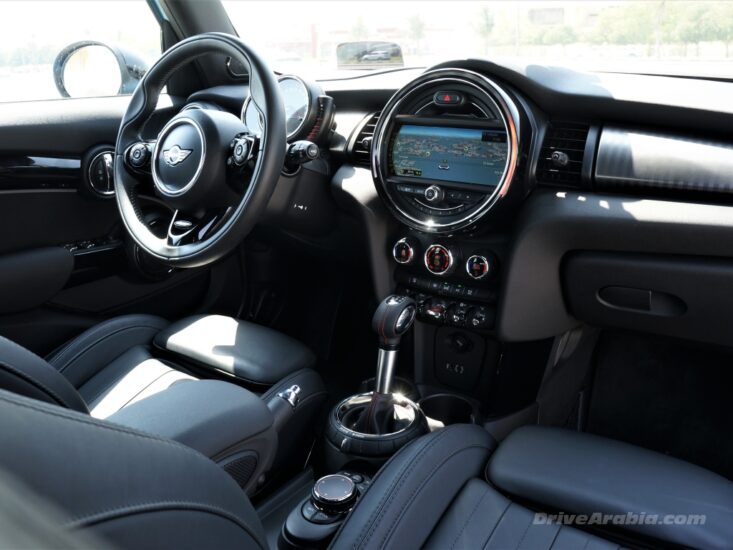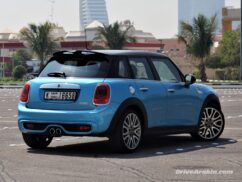2018 Mini Cooper S 5-Door
| The Good: – More refinement and comfort – Good engine for the most part – Fun to drive |
The Bad: – Price not fun – Still a cramped car – Handling less sharp than before |
Remember that time when Minis were actually….mini? We never had the pleasure of driving the original Mr. Bean-spec Mini, but we did drive every generation of the so-called “NEW MINI” (they market it with capital letters). The first generation of the new BMW-developed one was still an exciting little creature, bigger than the pint-sized classic, but featuring plenty of spunk and loads of darty fun. In fact, the Cooper S version only came with a manual gearbox, which speaks a lot about the company’s fun-loving intent. The second generation was an evolution of the first, growing only by 5 cm and featuring more refinements, yet keeping the same character and the obligatory manual gearbox in the Cooper S. Right after that, the company started going mainstream, delving into larger models such as the still-quirky 2-and-a-half-door Clubman and crossover SUVs such as the Countryman and the short-lived Paceman. Now in its third generation, the littlest Mini appears to have completely lost the plot.
The latest Mini hatch is a whopping 10 cm larger than the last one. And that’s just the 3-door. We’re driving the newly-introduced 5-door, which adds yet another 15 cm to the length. Between this, the 4-door Clubman and the Countryman crossover, Mini’s transformation is complete as a full-fledged Kia rival, except with a much fatter price tag.
The model we’re driving is the one that debuted in 2015 and ran till early 2018, before it received a negligible facelift and other updates for the 2019 model-year. It is actually a great-looking car, still recognisable as a Mini, although it got panned by other critics for having big head and tail lights. Well, that and the fact that the entire car grew in size too.

That increase in size for the 5-door body style netted more space inside. Legroom and headroom up front is good, even if the front passengers sit close together, although it is still unfortunately a cramped car for rear occupants, who can just about squeeze in and stare that the “Union Jack” on the back of the front headrests. In fact, there are British flags all over the interior, as if reminding you it’s really not German.
Storage is limited, with two cup-holders, a small cubby over the glove box, a small armrest cubby and slim door pockets. And the boot has just enough space for a medium-sized suitcase or a week’s worth of groceries. The rear seat can fold down to increase cargo room.
The cabin design is less quirky than before, but some elements are retained, such as the separate-from-the-dash gauge cluster, funky toggle switches and the aforementioned flag patterns on the headrests. Interior materials are good for the most part, with soft touch surfaces and nice leather upholstery, but there are still too many cheap plastic bits for the price.
The big infotainment screen has pretty graphics, but its controller is in an awkward position, nestled between the gear shifter and the central armrest. Navigation, Bluetooth and other settings can be fiddled with using the pathetic controller, but touchscreen functionality and Apply Carplay were only introduced with the mid-2018 facelift. Safety features include a full set of airbags, ESP, ABS and all the usual, as well as adaptive cruise control, rear camera and parking sensors.

While lower-spec Minis have moved on to 3-cylinder engines, the Cooper S got a bigger 2.0-litre turbo-four from BMW that produces 192 hp and 280 Nm, with peak torque available at 1250 rpm. It’s a good engine, with no obvious lag, a fairly quick 6-speed automatic gearbox with responsive paddle shifters (so the move to a 7-speed dual-clutch auto in mid-2018 adds needless complication), and a nice grunty exhaust. But for all that kick at the low end, it is a bit lifeless as the revs near the redline. A Mini Cooper S also begs for a manual gearbox, otherwise it feels just like any other warm hatch.
It can do the 0-100 kph run in about 6.9 seconds and burned fuel at a rate of 10.2 litres/100 km — not quite fast or frugal for the asking price.
Handling has been the reborn Mini’s unique selling point for the past two decades, and while the latest generation is still impressively agile, it clearly has lower limits in the tightest corners. It’s pretty much the only situation where its larger size becomes obvious, as understeering tyre squeal sets in earlier, although we have to admit, the car still offers good grip from its 205/40 tyres wrapping the 18-inch alloys.
It still offers the most go-kart-like handling in this segment, and even has a “go-kart” mode, whatever superficial change that does in a car with non-adaptive suspension.
The sharp and direct steering offers mild feedback, which is a downer compared to older models. For that trade-off, you get get a slightly less-firm ride with moderate cabin noise. It’s definitely more quiet than before, and reasonably comfortable on the highway commute. The mirrors are small, but all-round visibility is good and it’s easy enough to park due to its small size, even if bigger than before.
The Mini Cooper S continues its transition towards becoming a more “regular” car, which is a shame, considering they are dumbing down its previous strengths. If car buyers really wanted more comfort, they could pick literally anything else in the bloated Mini line-up. The new car is more refined than before, but now has a fatter price tag as well. You could buy a nice comfortable midsize SUV for the same amount of money if all you really want is a daily driver. The standard Mini should have been left alone as a niche product, at a much lower price.
| Price Range: Dh 165,000-175,000 Current Model Introduced in: Body Styles: Engines: Transmissions: Setup: Suspension: |
Brakes: Front: discs Rear: discs Curb Weight: Length: Wheelbase: Top Speed: Test Acceleration 0-100 kph: Observed Test Fuel Economy: |
















There are no comments. Be the first!